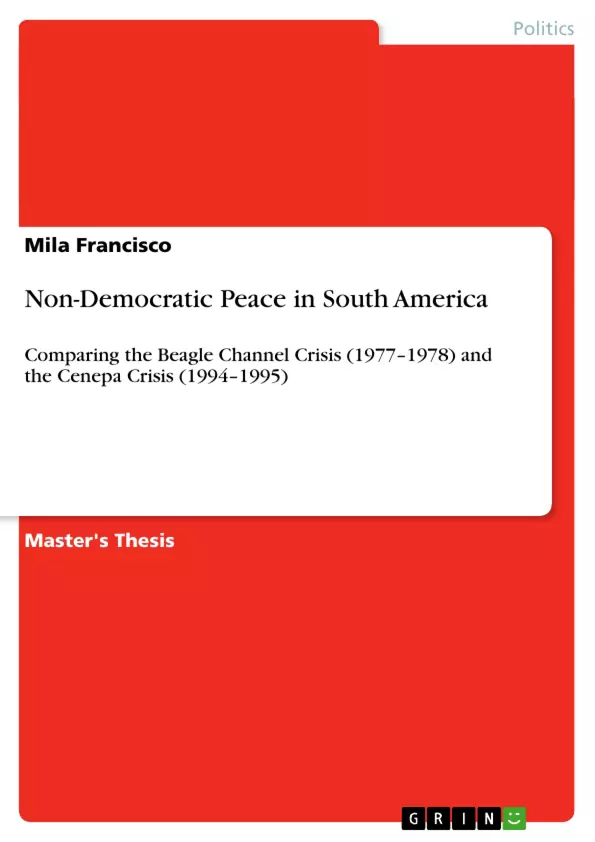The following study develops a structured focused comparison of two South American territorial crises: the Beagle Channel Crisis between Argentina and Chile (1977–1978) and the Cenepa Crisis between Ecuador and Peru (1994–1995). From a conventional perspective, the Beagle Channel Crisis should have escalated to war because it was a fully militarized inter-state crisis carried out by a military dyad. In contrast, the Cenepa Crisis should not have ended in war because it was a democratic dyad and the dissatisfied state was the weaker power. Yet the opposite happened in both cases: in the Beagle Channel Crisis the escalation process was contained, whereas in the Cenepa Crisis the situation escalated into an intensive war.
Based on a comparison of these two dyads, this study argues that deterrence strategy alone is not sufficient to prevent war. Only an interaction of deterrence strategy and third party involvement can contain an escalatory process, constituting a tool for strengthening deterrence.
Inhaltsverzeichnis (Table of Contents)
- Introduction
- Part I. Theoretical Framework
- Deterrence: Success and Failure
- Third Party Intervention and War Prevention
- Working Hypotheses
- Part II. The Beagle Channel Crisis (Argentina vs. Chile 1977-1978)
- Origins
- Actors: The Military in Power
- Claims
- Onset
- Escalation
- De-escalation
- Why Did the Crisis Not Escalate to War?
- Part III. The Cenepa Crisis (Ecuador vs. Peru 1994–1995)
- Origins
- Actors: Democracy vs. Democracy?
- Claims
- Onset
- Escalation
- De-escalation
- Why did the Crisis Escalate to War?
- Part IV. Did Regime Type Influence the Crises' Outcomes?
- Regime Type and War
- Regime Type, Deterrence and Third Party Intervention
Zielsetzung und Themenschwerpunkte (Objectives and Key Themes)
This study conducts a structured comparison of two South American territorial crises: the Beagle Channel Crisis (1977-1978) and the Cenepa Crisis (1994-1995). The objective is to analyze why the Beagle Channel Crisis, involving a fully militarized dyad, did not escalate to war, while the Cenepa Crisis, involving a democratic dyad, did. The study aims to determine whether deterrence strategy alone is sufficient to prevent war, or if third-party involvement plays a crucial role.
- The role of deterrence in preventing war
- The impact of third-party intervention on conflict escalation
- The influence of regime type (military vs. democratic) on conflict outcomes
- Analysis of territorial disputes in South America
- Comparison of the escalation and de-escalation processes in both crises
Zusammenfassung der Kapitel (Chapter Summaries)
The Introduction establishes the historical context of territorial disputes in Latin America, focusing on the legacy of colonial borders and the development of "territory sensitivity" among neighboring states. Part I lays out the theoretical framework, examining the successes and failures of deterrence strategies and the role of third-party intervention in preventing war. Part II details the Beagle Channel Crisis, exploring its origins, actors, claims, escalation, and eventual de-escalation, questioning why it avoided war. Part III similarly analyzes the Cenepa Crisis, covering its origins, actors, claims, escalation, and the reasons for its escalation to war. Part IV then begins to explore the relationship between regime type and the outcomes of each crisis, without reaching any conclusions.
Schlüsselwörter (Keywords)
South America, Beagle Channel Crisis, Cenepa Crisis, Argentina, Chile, Ecuador, Peru, deterrence, third-party intervention, regime type, military dictatorship, democracy, territorial disputes, conflict escalation, war prevention.
- Arbeit zitieren
- Mila Francisco (Autor:in), 2007, Non-Democratic Peace in South America, München, GRIN Verlag, https://www.grin.com/document/122504



